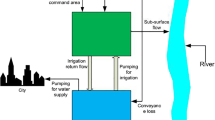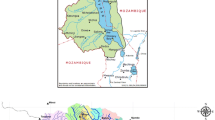Abstract
The Valley of Puebla aquifer (VPA), at the central region of Mexico, is subject to intensive exploitation to satisfy the urban and industrial demand in the region. As a result of this increased exploitation, a number of state and federal agencies in charge of water management are concerned about the problems associated with the aquifer (decline of groundwater table, deterioration in water quality, poor well productivity and increased pumping and water treatment costs). This study presents a groundwater management model that combines “MODFLOW” simulation with optimization tools “MODRSP”. This simulation–optimization model for groundwater evaluates a complex range of management options to identify the strategies that best fit the objectives for allocating resources in the VPA. Four hypothetical scenarios were defined to analyze the response of the hydrogeological system for future pumping schemes. Based on the simulation of flow with the MODFLOW program, promising results for the implementation of the optimization of water quantity were found in scenarios 3 and 4. However, upon comparison and analysis of the feasibility of recovery of the piezometric level (considering the policy of gradual reductions of pumping), scenario 4 was selected for optimization purposes. The response functions of scenario 4 were then obtained and optimized, establishing an extraction rate of 204.92 millions of m3/year (Mm3/year). The reduction in groundwater extraction will be possible by substituting the volume removed by 35 wells (that should be discontinued) by the same volume of water from another source.








Similar content being viewed by others
References
Anderson MP, Woessner W (1992) Applied groundwater modeling: simulation of flow and advective transport. Academic Press, New York, p 381
CONAGUA (2000) Actualización Hidrogeológica del Acuífero Alto Atoyac, Estado de Tlaxcala, Departamento de Aguas Subterráneas, Subgerencia Técnica, Gerencia Estatal Tlaxcala, México
CONAGUA (2003) Determinación de la Disponibilidad de agua subterránea en el acuífero Valle de Puebla, Estado de Puebla, Gerencia de Aguas Subterráneas, Subgerencia de Evaluación y Modelación Hidrogeológica, México
CONAGUA (2004) Zonas de reserva de agua potable para la Ciudad de Puebla, Pue. Gerencia de Aguas Subterráneas, Subgerencia de Evaluación and Modelación Hidrogeológica, Mexico
CONAGUA (2010) REPDA Registro Público de Derechos de Agua Online IOP. http://www.cna.gob.mx/Repda.aspx?n1=5&n2=37&n3=115. Accessed 31 May 2010
CONAGUA-IMTA (2007) Manejo Integrado de las aguas subterráneas en los Acuíferos Puebla- Alto Atoyac, Estados de Puebla and Tlaxcala. Gerencia de Aguas Subterráneas, Mexico
Das A, Bithin D (2001) Application of optimization techniques in groundwater quantity and quality management. Sadhana 26(4):293–316
Elwell BO, Lall U (1988) Determination of an optimal aquifer yield, with salt-lake county applications. J Hydrol 104(1–4):273–287
Flores-Márquez EL, Jiménez-Suárez G, Martínez-Serrano RG, Chavéz RE, Silva-Pérez D (2006) Study of geothermal water intrusion due to groundwater exploitation in the Puebla Valley aquifer system, Mexico. Hydrogeol J 14(7):1216–1230
Gárfias J, Arroyo N, Aravena R (2010) Hydrochemistry and origins of mineralized waters in the Puebla aquifer system, Mexico. Environ Earth Sci 59(8):1789–1805
Geotecnología S A (1997) Actualización del estudio geohidrológico de los acuíferos de Valle de Puebla, Sistema Operador de Agua potable and Alcantarillado de Puebla (SOAPAP), México
Gorelick SM (1983) A review of distributed parameter groundwater management modeling methods. Water Resour Res 19(2):305–319
Gorelick SM, Remson I (1982) Optimal location and management of waste disposal facilities affecting ground water quality. Water Resour Bull 18(1):43–51
Harou JJ, Lund J (2008) Representing groundwater in water management models—applications in California. California Energy Commission Public Interest Energy Research Program Report. http://www.energy.ca.gov/2008publications/CEC-500-2008-092/CEC-500-2008-092-REV.PDF. Accessed 20 September 2010
Harou JJ, Pulido-Velazquez M, Rosenberg DE, Medellin-Azuara J, Lund JR, Howitt RE (2009) Hydroeconomic models: concepts, design, applications, and future prospects. J Hydrol 375(3–4):627–643
Heidari M (1982) Application of linear systems theory and linear programming to groundwater management in Kansas. Water Resour Bull 18(6):1003–1012
Kemper K, Foster S, Garduño H, Nanni N, Tuinhof A (2004) Economic Instruments for Groundwater Management. Using incentives to improve sustainability. Brief Note 7 World Bank, Washington DC, pp 1–8
Larson KJ, Basagaoglu H, Marino MA (2001) Prediction of optimal safe ground water yield and land subsidence in the Los Banos-Kettleman City area, California, using a calibrated numerical simulation model. J Hydrol 242(1–2):79–102
Lesser and Asociados SA De CV (1982) Estudio Geohidrológico de la zona río Atoyac, Estado de Puebla. Gerencia de Aguas Subterráneas, Subgerencia de Evaluación and Modelación Hidrogeológica. CNA-SARH, México
Lindo Systems Inc (2011) LINDO 6.1 Systems—optimization software: integer programming, linear programming. http://www.lindo.com/
Maddock T III (1972) Algebraic technological function from a simulation model. Water Resour Res 8(1):129–134
Maddock T III, Lacher L (1991) MODRSP: a program to calculate drawdown, velocity, storage and capture response functions for multi-aquifer systems. HWR Report No. 91-020, Department of Hydrology and Water Resources, University of Arizona, Tucson, Arizona
McDonald MG and Harbaugh AW (1988) MODFOW, a modular three-dimensional finite difference ground-water flow model- U-S.G.S. Open file report 83-875
McPhee J, Yeh WWG (2004) Multiobjective optimization for sustainable groundwater management in semiarid regions. J Water Resour Plann Manage 130(6):490–497
Nishikawa T (1998) Water resources optimization model for Santa Barbara, California. J Water Resour Plan Manage 124(5):252–263
Waller-Barrera C, Medellín-Azuar J, Lund JR (2009) Optimización económico-ingenieril del suministro agrícola y urbano: una aplicación de reúso del agua en Ensenada, Baja California, México. Ingeniería Hidráulica en México 26(4):87–103
Zhou X, Chen M, Liang C (2003) Optimal schemes of groundwater exploitation for prevention of sea water intrusion in the Leizhou Peninsula in southern China. Environ Geol 43:978–985
Author information
Authors and Affiliations
Corresponding author
Rights and permissions
About this article
Cite this article
Salcedo-Sánchez, E.R., Esteller, M.V., Garrido Hoyos, S.E. et al. Groundwater optimization model for sustainable management of the Valley of Puebla aquifer, Mexico. Environ Earth Sci 70, 337–351 (2013). https://doi.org/10.1007/s12665-012-2131-z
Received:
Accepted:
Published:
Issue Date:
DOI: https://doi.org/10.1007/s12665-012-2131-z




